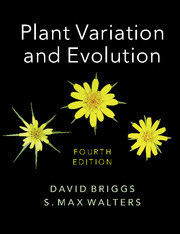Book contents
- Frontmatter
- Contents
- Preface to the Fourth Edition
- Acknowledgements
- Note on names of plants
- List of abbreviations
- 1 Investigating plant variation and evolution
- 2 From Ray to Darwin
- 3 Early work on biometry
- 4 Early work on the basis of individual variation
- 5 Post-Darwinian ideas about evolution
- 6 DNA: towards an understanding of heredity and molecular evolution
- 7 Breeding systems
- 8 Intraspecific variation and the ecotype concept
- 9 Pattern and process in plant populations
- 10 Pattern and process: factors interacting with natural selection
- 11 Populations: origins and extinctions
- 12 Species and speciation: concepts and models
- 13 Allopatric speciation and hybridisation
- 14 Abrupt speciation
- 15 The species concept
- 16 Flowering plant evolution: advances, challenges and prospects
- 17 Historical biogeography
- 18 The evolutionary impact of human activities
- 19 The taxonomic challenge ahead
- 20 Conservation: from protection to restoration and beyond
- Glossary
- References
- Index
6 - DNA: towards an understanding of heredity and molecular evolution
Published online by Cambridge University Press: 05 June 2016
- Frontmatter
- Contents
- Preface to the Fourth Edition
- Acknowledgements
- Note on names of plants
- List of abbreviations
- 1 Investigating plant variation and evolution
- 2 From Ray to Darwin
- 3 Early work on biometry
- 4 Early work on the basis of individual variation
- 5 Post-Darwinian ideas about evolution
- 6 DNA: towards an understanding of heredity and molecular evolution
- 7 Breeding systems
- 8 Intraspecific variation and the ecotype concept
- 9 Pattern and process in plant populations
- 10 Pattern and process: factors interacting with natural selection
- 11 Populations: origins and extinctions
- 12 Species and speciation: concepts and models
- 13 Allopatric speciation and hybridisation
- 14 Abrupt speciation
- 15 The species concept
- 16 Flowering plant evolution: advances, challenges and prospects
- 17 Historical biogeography
- 18 The evolutionary impact of human activities
- 19 The taxonomic challenge ahead
- 20 Conservation: from protection to restoration and beyond
- Glossary
- References
- Index
Summary
A revolution in biology is in progress – no less of a revolution than that caused by Darwin's theory of evolution by natural selection. The achievements of molecular biology have been so great and the progress so rapid that an enormous body of information now exists. In this chapter we focus on several key issues that are important in understanding later chapters.
• How the properties of nucleic acids provide the basis of heredity.
• Why molecular insights are changing our view of the mechanisms of evolution.
• How intensive molecular genetic studies of model flowering plant species (particularly Arabidopsis thaliana and a variety of crop plants) are revolutionising studies of many areas of plant biology.
• As the results of molecular investigations into these model and representative organisms for all the major groups are becoming available, do these point to a common origin for life on Earth? And what does the comparison of genomes of different groups indicate about evolutionary changes in gene order, chromosome number, the fate of duplicated DNA segments etc.?
• Finally, what are the key molecular techniques for studying pattern and processes in populations and species, and what properties of DNA have been exploited to allow, through sequencing and computational methods, spectacular insights into the evolution of the flowering plant branches of the Tree of Life?
Obviously, in this short book, we must be content to provide an outline of the ways in which this new knowledge of molecular biology illuminates these key questions. For comprehensive accounts of historical and recent developments in molecular biology, Clark (2005), Allison (2007), Craig et al. (2010) and Watson et al. (2014) should be consulted. For detailed accounts of our present understanding of the molecular biology of plants, see Smith et al. (2010), Jones et al. (2012) and Grotewold, Chappell & Kellogg (2015).
DNA: its structure and properties
The early geneticists visualised genes as ‘beads threaded on a string’. In 1944 Schrödinger, in his fascinating book What Is Life?, suggested that genes could be complex organic molecules in which endless possible variations in detailed atomic structure could be responsible for codes specifying the stages of development. Since the1950s, spectacular progress has been made in our understanding of the structure of the hereditary materials and how they work.
- Type
- Chapter
- Information
- Plant Variation and Evolution , pp. 74 - 97Publisher: Cambridge University PressPrint publication year: 2016



